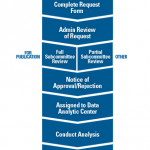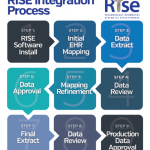 Seasoned rheumatologists remember the good old days of clinical practice when a patient encounter lasted more than 10 minutes and documentation of that visit took less than an hour. In today’s healthcare environment, which is driven by electronic health records (EHRs) and quality measure reporting, rheumatologists are more cogs in the data machine than clinicians.
Seasoned rheumatologists remember the good old days of clinical practice when a patient encounter lasted more than 10 minutes and documentation of that visit took less than an hour. In today’s healthcare environment, which is driven by electronic health records (EHRs) and quality measure reporting, rheumatologists are more cogs in the data machine than clinicians.
The literature and mainstream media have long documented integrity issues with regard to data collection, most notably copy-and-paste errors and poor system designs. A study in the Journal of Patient Safety that looked at 300,000 malpractice claims showed health IT-related errors were more prevalent in ambulatory settings.1,2,3
Rheumatologists must care about the quality of the data they collect and disseminate, “because it is going to affect your patients, your clinical decision making and your practice. We want the cleanest data available,” says rheumatologist Puneet Bajaj, MD, MPH, of the University of Texas, Southwestern in Dallas, and one of the newest members of the ACR’s Registries and Health Information Technology (RHIT) Committee. “Basically, ‘clean’ data means high-fidelity data that can be trusted and relied on as the single source of truth. That is valuable to your patients and your practice, [because] it affects clinical decision support and health outcomes.”
Technology, data and quality reporting are becoming more important to medical practices, and you must understand their importance. He continues, “In the future, data on health outcomes may be available for patients to review online, and [reimbursement] that is based on the estimated value of a product or service could be a reality and common practice. Providers need to be committed to making changes in their practice and on their EHRs.”
Quality Data
“The ultimate goal is for RISE [the Rheumatology Informatics System for Effectiveness registry] to be a great feedback cycle for rheumatologists,” says Ryan Larosa, the ACR’s director of registry operations, noting his team works with hundreds of EHR vendors and continuously updates the RISE data dictionary. “The ACR develops guidelines for treatment, so ultimately, the goal is for the data we are getting from real-world practice to help guideline development and implementation.
“Real-world practice data are never going to be like a clinical trial. There are a lot of things doctors don’t have control of when it comes to patient compliance in those settings. … But our error rate is extremely low because our mapping process is intense up front.”
Technology
A perfect data transfer may be the goal, but errors are bound to occur and remain somewhat expected, Dr. Bajaj says. He suggests rheumatologists focus on avoiding the common mistakes and work with vendors to solve template and interoperability issues.
“Because of the way the system is right now, practices and providers benefit from seeing more patients in less time, [because] that equates to reimbursement. But the burden of documenting accurate data continues to fall on the providers. It is easy to click on the wrong check box or radio button. Human errors are going to happen; to err is human,” Dr. Bajaj says. “I think technology also plays a role [in the introduction of errors]. Technology allows providers to copy and paste from one note to another and build templates that can be pre-populated before the patient arrives, which increases the potential for error. Autocorrection during dictation can also produce errors. There could be human error within that, but technology is contributing to it.”
Dr. Bajaj says the RISE registry is using language processing “to read through notes to find key elements in the note and get the right data.” He says he could see an expanded role for artificial intelligence in the future to document and capture accurate data. For now, efforts are focused on more seamless connection and mapping of data between the clinician, the practice and the registry.
“Discreet areas [records fields] are easily captured by any registry,” he says. “These areas in a note or encounter can take only particular values and can be in the form of check boxes, radio buttons, selectable values or specific fields to input dates, etc. And rather than the machine language processing, where it has to go through the whole note to figure out the keywords, discreet areas are usually much more helpful. I think that it is a real concern for any registry—gathering the right data in the best way that avoids errors and poor data entry. I think all of us are trying to work to stay on top of it.”
RISE Results
Mr. Larosa says one issue RISE encounters is incomplete or inoperable data transfer from an EHR system. Sometimes an EHR isn’t able to transfer data to RISE; other times the EHR shares only a portion of the available data.
“It’s not that the data are bad,” Mr. Larosa says. “The data are either not coming through or not coming through in the way we need it to. Specifically, for RA, we experience this with cloud-based providers. They don’t send us everything. They only send us what they think we need for our quality measures. … That does not create false positives in the registry; it just doesn’t populate in the numbers we need it to.”
Dr. Bajaj, who is working closely to connect his institution with the RISE registry, says no rule of thumb exists for rheumatologists to abide by in this space, but sequential mapping and monitoring of their data on RISE can be very helpful. The specialty and its patients will improve if its providers stay committed to clean data entry and then put those data to work.
“Providers can, 1) use the data for benchmarking and doing quality improvement in their practice, and 2) do advanced research with big and high-quality data. But to make this successful, we need to make sure that the data in the RISE registry are correct and accurate,” he explains. “We need help from providers, because this is not something RISE or the RHIT Committee or the ACR can do by itself.”
Richard Quinn is a freelance writer in New Jersey.
References
- Miliard M. EHRs are overflowing with copy-and-paste records, JAMA study shows. HealthcareIT News. 2017 May 3.
- Bowman S. Impact of electronic health record systems on information integrity: Quality and safety implications. Perspect Health Inf Manag. 2013 Fall;10(Fall):1c.
- Graber ML, Siegal D, Riah H, et al. Electronic health record-related events in medical malpractice claims. J Patient Saf. 2015 Nov 6. [Epub ahead of print]



